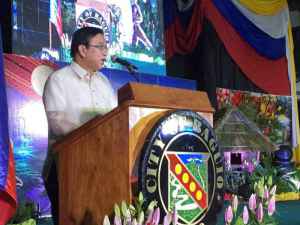Water district worried on depletion of city’s water supply
BAGUIO CITY – The Baguio Water District (BWD) has expressed concern over the depletion of water in the city, adding that private wells could be making the situation worse.
At the press conference on the 30th anniversary of the Baguio Regreening Movement (BRM) on August 29, BWD general manager Salvador Royeca said there is a big chance that water drilled from the city’s aquifer will further deteriorate because of “over-pumping,” especially during the summer season.
Aside from wells drilled by private water deliveries, some big hotels also drill their own water within their vicinity, Royeca noted, saying this adds to the lowering of the aquifer, where the BWD sources its supply for Baguio City residents.
He said the BWD hopes the National Water Resource Board (NWRB) will stop issuing permits for drilling of private wells.
He also asked that an inventory be done to determine the actual number of private wells that get the supply intended for all the city residents through the water district.
He said Baguio has a normal average consumption of 55,000 cubic meters daily during the summer season. But the production capability of the BWD is only at 42,587 cubic meters per day.
Royeca said the BWD has programs to bridge the gap between the supply and demand for water.
Among these are rationing, or the scheduling of water supply in some areas of the city, and encouraging the residents to stock up on their water tanks or containers for their consumption.
He added the BWD is also trying to cut down systems loss and make these revenue water instead.
Royeca is relieved to note though that the BWD has a 21-percent systems loss, lower than the allowable 25-30 percent rate for a utility that operates on a mixture of old and new system like the BWD. He said a utility service that operates on a 100-percent new system is allowed a 20-percent systems loss.
He said the BWD has just completed the Sto. Tomas rain catchment facility, which has started filling and will be used during the next summer season.
Other water supply projects are in the pipeline for the city, he said, such as the ongoing exploration programs and the Badiwan and Busol bulk water projects.
The city’s other rain catchment in the Busol watershed can hold 55,000 cubic meters daily, but the BWD had proposed to increase this to around 100,000 cubic meters. Busol supplies 40 percent of the household connections covered by the BWD.
Negotiations, he added, are also ongoing for the bulk water in Irisan, the biggest barangay in the city.
He said if all these projects are completed in two to three years’ time, Baguio would be able to close the gap between supply and demand.
He said the BWD projects aimed to improve water supply for Baguio are now 80 percent complete.
“Palapit na tayo nang palapit. Pag natapos na itong mga bulk water supplies and water impounding natin, we could say that mag-equate na ang demand and supply,” Royeca said.
The water utility serves 122 out of 129 barangays in Baguio and parts of Tuba, Benguet.
The water utility also maintains 60 active deep wells. LIZA AGOOT, PNA / ABN
Region 1 nakasaganan para iti National Crime Prevention Week
September 2, 2018
Headlines
LANDSLIDE SA ITOGON
July 5, 2025
NEW BAGUIO CITY OFFICIALS
July 5, 2025





